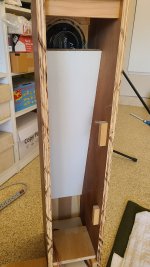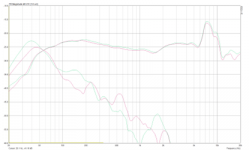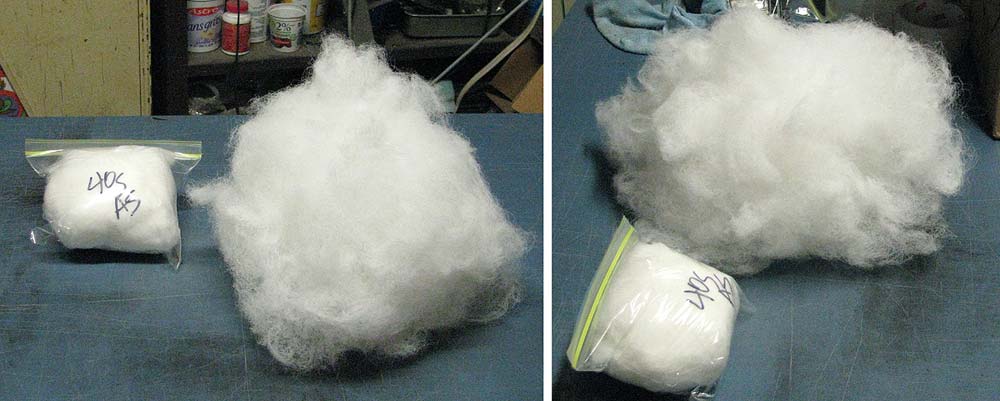I been lurking on this forum for a while, learning from the kind and knowledgable folks here. Thank you! Years ago, I built MLTL bass boxes based on a design of Paul Kittinger, using Martin King's programs. Loved it!
Now, I'm inspired by the Pensils and Sebelius to design and build an MLTL tower using Alpair 10.2's. To fit in my space, I'd like the cabinets to be a bit smaller than the Pensil. The first diagram gives the general dimensions. I did a bunch of modeling using Hornresp. The pictures show the model parameters I came up with. The modeled response looks pretty good to me, with a bump ~42hz. Mouth velocity is a little high near the driver x-max. Otherwise, I would have make a narrower shallower port. Did I model this correctly?
I built a test box and measured it. The test box is slightly larger than the model to allow for some adjustments. But, it's pretty close. The driver has ~150 hours of break-in time. The near field measurement look pretty good. And it sounds pretty good! The bass is extraordinary for such a small driver.
My first question is about the FR chart dips in the 100hz-200hz range. Some were measured at 3', others were measured at the listening position of 10'. Is this floor bounce (carpeted room)? Rear wall bounce? A gated measurement problem? Poor cab construction? Interference due to distance between the driver and port? Should I do anything about this?
My second question is about baffle step compensation. I find that the speaker sounds more natural with a ~2db baffle step shelf starting at ~1khz. Have any of you found the same? Do you think building a full-size Pensil would increase the low end and midrange enought to avoid the need for baffle step compensation?
Any advice would be appreciated!
Now, I'm inspired by the Pensils and Sebelius to design and build an MLTL tower using Alpair 10.2's. To fit in my space, I'd like the cabinets to be a bit smaller than the Pensil. The first diagram gives the general dimensions. I did a bunch of modeling using Hornresp. The pictures show the model parameters I came up with. The modeled response looks pretty good to me, with a bump ~42hz. Mouth velocity is a little high near the driver x-max. Otherwise, I would have make a narrower shallower port. Did I model this correctly?
I built a test box and measured it. The test box is slightly larger than the model to allow for some adjustments. But, it's pretty close. The driver has ~150 hours of break-in time. The near field measurement look pretty good. And it sounds pretty good! The bass is extraordinary for such a small driver.
My first question is about the FR chart dips in the 100hz-200hz range. Some were measured at 3', others were measured at the listening position of 10'. Is this floor bounce (carpeted room)? Rear wall bounce? A gated measurement problem? Poor cab construction? Interference due to distance between the driver and port? Should I do anything about this?
My second question is about baffle step compensation. I find that the speaker sounds more natural with a ~2db baffle step shelf starting at ~1khz. Have any of you found the same? Do you think building a full-size Pensil would increase the low end and midrange enought to avoid the need for baffle step compensation?
Any advice would be appreciated!
Attachments
-
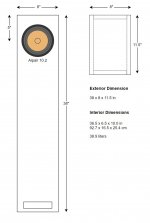 Screenshot 2022-09-01 213055.jpg66.8 KB · Views: 184
Screenshot 2022-09-01 213055.jpg66.8 KB · Views: 184 -
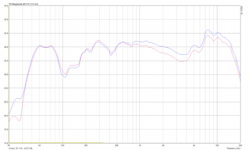 Picture9.png22.9 KB · Views: 191
Picture9.png22.9 KB · Views: 191 -
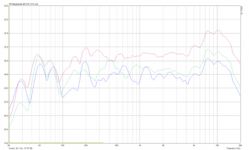 Picture8.png14.1 KB · Views: 151
Picture8.png14.1 KB · Views: 151 -
 Picture7.png17.7 KB · Views: 146
Picture7.png17.7 KB · Views: 146 -
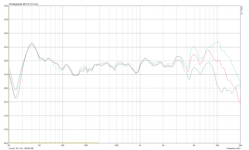 Picture6.png12.9 KB · Views: 148
Picture6.png12.9 KB · Views: 148 -
 Picture5.png12.4 KB · Views: 141
Picture5.png12.4 KB · Views: 141 -
 Picture4.png11.1 KB · Views: 157
Picture4.png11.1 KB · Views: 157 -
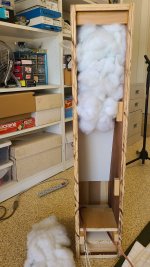 20220828_112659.jpg474.8 KB · Views: 305
20220828_112659.jpg474.8 KB · Views: 305 -
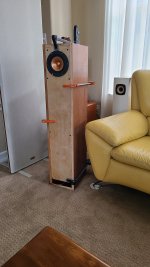 20220731_162751.jpg471.7 KB · Views: 192
20220731_162751.jpg471.7 KB · Views: 192 -
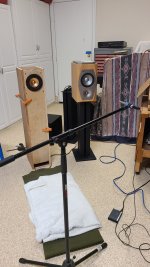 20220726_223458.jpg385.7 KB · Views: 182
20220726_223458.jpg385.7 KB · Views: 182 -
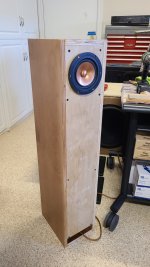 20220726_083808.jpg351.6 KB · Views: 163
20220726_083808.jpg351.6 KB · Views: 163 -
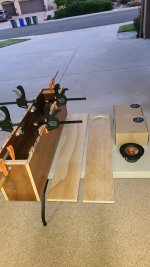 20220724_200355.jpg408.6 KB · Views: 172
20220724_200355.jpg408.6 KB · Views: 172 -
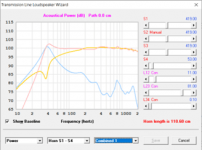 Picture3.png17.1 KB · Views: 170
Picture3.png17.1 KB · Views: 170 -
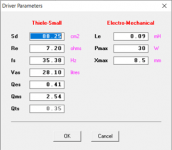 Picture2.png9.4 KB · Views: 157
Picture2.png9.4 KB · Views: 157 -
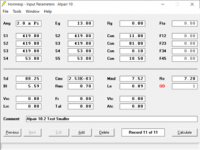 Picture1.png15.4 KB · Views: 173
Picture1.png15.4 KB · Views: 173
Last edited by a moderator:
Here's the Hornresp .dat file. I contains a few records that attempt to model similar designs. The "Test Build" records are the ones I'm working on:
- Test Build #1 - 42" tall
- Test Build #2 - 39" tall
- Test Build #3 - 38" tall, 0.5" narrower - same as the 1st diagram above
Attachments
So which design are you trying to copy, because they are different? Also in pic #8 you've got a lot of tightly wadded stuffing. What's the deal with that?Now, I'm inspired by the Pensil's and Sebelius to design and build an MLTL tower using Alpair 10.2's.
jeff
I had both in mind designs at the start and modeled them both in Hornresp. Those in the .dat file I posted. I'm fairly new to Hornresp, so I may not have done it right. I modeled Sebelius as an expanding TL with moderately deep port. I modelled the Pensil 10.3 as an MLTL with a 1.5cm deep port. With the same exterior dimensions, I didn't see the advantge of the expanding TL, so I went with a constant area (no divider). I also threw a diagonal divider in my test box and measured it. I didn't seem to help. See the red line on the FR chart.So which design are you trying to copy, because they are different?
So, I guess I'm copying the Pensil design with a deeper port and smaller cross section area.
That's me now knowing how tight or loose to pack it. I'm trying follow the guideline of stuffing in the top half. Way too tight?Also in pic #8 you've got a lot of tightly wadded stuffing. What's the deal with that?
Attachments
I modelled the Pensil 10.3 as an MLTL with a 1.5cm deep port.
The depth of the terminus should be 18-20mm.
dave
Thank you Dave! I've updated my Hornresp model to have a 19mm terminus depth. BTW, does anyone know what kind of value should I use for the filling density and what that equates to in oz/cuft? I put 1000 - 1500 in the modelbecuase it seemed to damp out the most of the harmonics without killing the low end. But I'm really just guessing.
Attachments
HR dat file? I'm wanting the txt record files.Here's the Hornresp .dat file.
Re when to use differing pipe tapers.
Re floor bounce, you tell us. 😉
Reflections (eigenmodes) are 1/2 WL, so you'll have to measure any other reflections, then Hz = (SoS/distance)/2.
Increasing net volume (Vb) just makes the cab that much more under damped (peaking around Fb).
Re the Pensil, Scott and I talked about it way back when and IIRC it was basically a classic leaky sealed box except high aspect ratio that 'swamped' the driver's compliance and loosely stuffed to maximize acoustic efficiency, so shrinking it moves it closer to a MLTL, though still too big as its bump at Fb indicates.
Anyway, while there's nothing technically wrong with your sim other than requiring way too much stuffing density IME, so to keep it 'classic' I'll outline a new sim.
BTW, can it be taller and is the 33" driver height your ideal or?
Reflections (eigenmodes) are 1/2 WL, so you'll have to measure any other reflections, then Hz = (SoS/distance)/2.
Increasing net volume (Vb) just makes the cab that much more under damped (peaking around Fb).
Re the Pensil, Scott and I talked about it way back when and IIRC it was basically a classic leaky sealed box except high aspect ratio that 'swamped' the driver's compliance and loosely stuffed to maximize acoustic efficiency, so shrinking it moves it closer to a MLTL, though still too big as its bump at Fb indicates.
Anyway, while there's nothing technically wrong with your sim other than requiring way too much stuffing density IME, so to keep it 'classic' I'll outline a new sim.
BTW, can it be taller and is the 33" driver height your ideal or?
you tell us.
Using the sketch below with 37" driver height of the current box, I get:
- 146hz if measured at 36"
- 216hz if measured at 72"
- 321hz if measured at 120" (aprox listening distance
It could be taller - up to ~41" exterior height and ~36" driver height. My listening height is ~35".BTW, can it be taller and is the 33" driver height your ideal or?
Attachments
Yeah you need to tease it out until it's quite fluffy.That's me now knowing how tight or loose to pack it. I'm trying follow the guideline of stuffing in the top half. Way too tight?
jeff
We used to call it 'tickling' and when pinkish insulation came along it was of course referred to as 'tickled pink'. 😉
The picture really helps for the stuffing. I was way too dense 😉 Any idea what value I should put into Hornresp to model that density?
- Home
- Loudspeakers
- Full Range
- Help with MLTL for Alpair 10.2?
